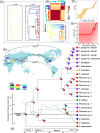The saprotrophic Pleurotus ostreatus species complex: late Eocene origin in East Asia, multiple dispersal, and complex speciation
- PMID: 32617259
- PMCID: PMC7325090
- DOI: 10.1186/s43008-020-00031-1
The saprotrophic Pleurotus ostreatus species complex: late Eocene origin in East Asia, multiple dispersal, and complex speciation
Abstract
The Pleurotus ostreatus species complex is saprotrophic and of significant economic and ecological importance. However, species delimitation has long been problematic because of phenotypic plasticity and morphological stasis. In addition, the evolutionary history is poorly understood due to limited sampling and insufficient gene fragments employed for phylogenetic analyses. Comprehensive sampling from Asia, Europe, North and South America and Africa was used to run phylogenetic analyses of the P. ostreatus species complex based on 40 nuclear single-copy orthologous genes using maximum likelihood and Bayesian inference analyses. Here, we present a robust phylogeny of the P. ostreatus species complex, fully resolved from the deepest nodes to species level. The P. ostreatus species complex was strongly supported as monophyletic, and 20 phylogenetic species were recognized, with seven putatively new species. Data from our molecular clock analyses suggested that divergence of the genus Pleurotus probably occurred in the late Jurassic, while the most recent common ancestor of the P. ostreatus species complex diversified about 39 Ma in East Asia. Species of the P. ostreatus complex might migrate from the East Asia into North America across the North Atlantic Land Bridge or the Bering Land Bridge at different times during the late Oligocene, late Miocene and late Pliocene, and then diversified in the Old and New Worlds simultaneously through multiple dispersal and vicariance events. The dispersal from East Asia to South America in the middle Oligocene was probably achieved by a long-distance dispersal event. Intensification of aridity and climate cooling events in the late Miocene and Quaternary glacial cycling probably had a significant influence on diversification patterns of the complex. The disjunctions among East Asia, Europe, North America and Africa within Clade IIc are hypothesized to be a result of allopatric speciation. Substrate transitions to Apiaceae probably occurred no earlier than 6 Ma. Biogeographic analyses suggested that the global cooling of the late Eocene, intensification of aridity caused by rapid uplift of the QTP and retreat of the Tethys Sea in the late Miocene, climate cooling events in Quaternary glacial cycling, and substrate transitions have contributed jointly to diversification of the species complex.
Keywords: Diversification; East Asian origin; Illumina MiSeq; Molecular phylogeny; Saprotrophic mushrooms; Species recognition.
© The Author(s) 2020.
Conflict of interest statement
Competing interestsThe authors declare that they have no competing interests.
Figures



Similar articles
-
Multi-locus phylogeny of lethal amanitas: implications for species diversity and historical biogeography.BMC Evol Biol. 2014 Jun 21;14:143. doi: 10.1186/1471-2148-14-143. BMC Evol Biol. 2014. PMID: 24950598 Free PMC article.
-
Biogeographic diversification of Mahonia (Berberidaceae): Implications for the origin and evolution of East Asian subtropical evergreen broadleaved forests.Mol Phylogenet Evol. 2020 Oct;151:106910. doi: 10.1016/j.ympev.2020.106910. Epub 2020 Jul 21. Mol Phylogenet Evol. 2020. PMID: 32702526
-
Biogeography of land snail genus Acusta (Gastropoda: Camaenidae): Diversification on East Asian islands.Mol Phylogenet Evol. 2021 Feb;155:106999. doi: 10.1016/j.ympev.2020.106999. Epub 2020 Oct 30. Mol Phylogenet Evol. 2021. PMID: 33130300
-
Diversification of East Asian subtropical evergreen broadleaved forests over the last 8 million years.Ecol Evol. 2022 Oct 30;12(11):e9451. doi: 10.1002/ece3.9451. eCollection 2022 Nov. Ecol Evol. 2022. PMID: 36329812 Free PMC article. Review.
-
Global advances in phylogeny, taxonomy and biogeography of Lauraceae.Plant Divers. 2025 Apr 7;47(3):341-364. doi: 10.1016/j.pld.2025.04.001. eCollection 2025 May. Plant Divers. 2025. PMID: 40496996 Free PMC article. Review.
Cited by
-
The evolution of ectomycorrhizal symbiosis and host-plant switches are the main drivers for diversification of Amanitaceae (Agaricales, Basidiomycota).BMC Biol. 2024 Oct 10;22(1):230. doi: 10.1186/s12915-024-02031-8. BMC Biol. 2024. PMID: 39390520 Free PMC article.
-
Comparative genomic analysis of pleurotus species reveals insights into the evolution and coniferous utilization of Pleurotus placentodes.Front Mol Biosci. 2023 Nov 6;10:1292556. doi: 10.3389/fmolb.2023.1292556. eCollection 2023. Front Mol Biosci. 2023. PMID: 38028535 Free PMC article.
-
Phylogenetic and taxonomic updates of Agaricales, with an emphasis on Tricholomopsis.Mycology. 2023 Nov 7;15(2):180-209. doi: 10.1080/21501203.2023.2263031. eCollection 2024. Mycology. 2023. PMID: 38813470 Free PMC article.
-
The genome sequence of the oyster mushroom, Pleurotus ostreatus ((Jacq.) P. Kummer, 1871).Wellcome Open Res. 2023 Jun 26;8:277. doi: 10.12688/wellcomeopenres.19578.1. eCollection 2023. Wellcome Open Res. 2023. PMID: 38784713 Free PMC article.
-
Wood-loving magic mushrooms from Australia are saprotrophic invaders in the Northern Hemisphere.Fungal Syst Evol. 2024 Dec;14:209-217. doi: 10.3114/fuse.2024.14.14. Epub 2024 Jul 19. Fungal Syst Evol. 2024. PMID: 39830294 Free PMC article.
References
-
- AI-Tanlimi S, Charleston MA, Clayton DH, Demastes JW, Gray RD, et al. Tangled trees: phylogeny, cospeciation, and coevolution. Chicago: University of Chicago Press; 2003.
-
- Akaike H. Likelihood of a model and information criteria. Journal of Econometrics. 1981;16:3–14. doi: 10.1016/0304-4076(81)90071-3. - DOI
-
- Albertó EO, Petersen RH, Hughes KW, Lechner B. Miscellaneous notes on Pleurotus. Persoonia. 2002;18:55–69.
LinkOut - more resources
Full Text Sources
